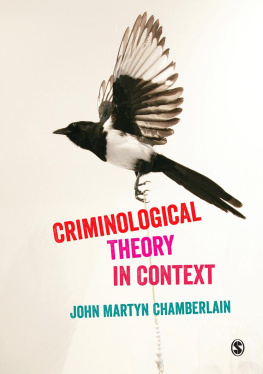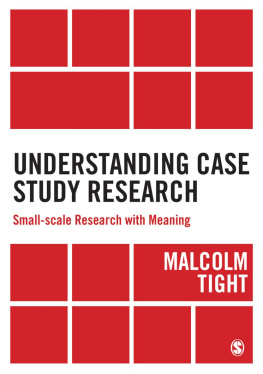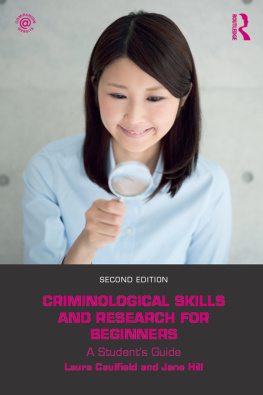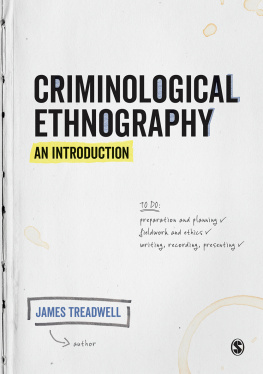UNDERSTANDING
CRIMINOLOGICAL
RESEARCH
SAGE has been part of the global academic community since 1965, supporting high quality research and learning that transforms society and our understanding of individuals, groups and cultures. SAGE is the independent, innovative, natural home for authors, editors and societies who share our commitment and passion for the social sciences.
Find out more at: www.sagepublications.com
UNDERSTANDING
CRIMINOLOGICAL
RESEARCH
a guide to data analysis
JOHN MARTYN CHAMBERLAIN
SAGE Publications Ltd
1 Olivers Yard
55 City Road
London EC1Y 1SP
SAGE Publications Inc.
2455 Teller Road
Thousand Oaks, California 91320
SAGE Publications India Pvt Ltd
B 1/I 1 Mohan Cooperative Industrial Area
Mathura Road
New Delhi 110 044
SAGE Publications Asia-Pacific Pte Ltd
3 Church Street
#1004 Samsung Hub
Singapore 049483
Editor: Natalie Aguilera
Editorial assistant: James Piper
Production editor: Rachel Eley
Copyeditor: Jill Birch
Proofreader: Jonathan Hopkins
Marketing manager: Sally Ransom
Cover design: Wendy Scott
Typeset by: C&M Digitals (P) Ltd, Chennai, India
Printed by: MPG Books Group, Bodmin, Cornwall
John Martyn Chamberlain 2013
First published 2013
Apart from any fair dealing for the purposes of research or private study, or criticism or review, as permitted under the Copyright, Designs and Patents Act, 1988, this publication may be reproduced, stored or transmitted in any form, or by any means, only with the prior permission in writing of the publishers, or in the case of reprographic reproduction, in accordance with the terms of licences issued by the Copyright Licensing Agency. Enquiries concerning reproduction outside those terms should be sent to the publishers.
Library of Congress Control Number: 2012933330
British Library Cataloguing in Publication data
A catalogue record for this book is available from the British Library
ISBN 9781-44620857-1
ISBN 9781-44620858-8 (pbk)
For my daughter Freyja,
because she understands why I still need her hand to hold,
particularly when crossing the street.
For my nana Freda,
as without her I wouldnt have taken this path.
Contents
About the Author
Dr Chamberlain is a Senior Lecturer in Criminology and Social Policy in the Department of Social Science at Loughborough University. His academic background and research interests cross over the fields of criminology and medical sociology. Drawing on both fields, over the last decade and a half he has conducted research in a range of topics, including the care and treatment of mentally disordered offenders within the prison system, the identification and punishment of health practitioners who deliberately harm patients, as well as the surveillance and control of civil disobedience and public protest by crime control agencies, such as the police. Currently he is conducting research into contemporary developments in the risk management and treatment of offenders classified by the criminal justice system as dangerous, including violent and sex offenders, mentally disordered offenders and terrorists.
1
An Autobiographical Introduction
CHAPTER OVERVIEW
introduces the focus of this book on providing an introduction to how qualitative and quantitative data analysis is undertaken by criminologists. The chapter outlines the importance of numbers and words for exploring criminal life and discusses how, although criminology is a highly diverse and fragmented discipline, at its centre lies a common commitment to undertaking rigorous and systematic empirical research as a member of a broader academic community. The chapter ends with a brief summary of subsequent chapter content.
CHAPTER CONTENTS
The importance of words and numbers
The triangle of criminology
Purpose and structure of this book
Chapter reading list
The Importance of Words and Numbers

This book provides an introduction to different forms of data analysis used by criminologists to explore and examine the social world using words and numbers. A range of approaches to the analysis of narrative and numeric data are examined, including grounded theory analysis, narrative analysis, discourse analysis, univariate analysis and bivariate analysis. There are several research methods texts specific to criminology which provide students with help managing a research project (i.e. King and Wincup 2007; Crowe and Semmens 2008; Davies et al. 2011). Yet these texts dont focus in detail on the mechanics of doing different forms of data analysis. In addition to providing practical examples of how to do data analysis this book seeks to contextualise its content to help the reader understand the underlying key principles that serve to shape the analytic process. It does this by outlining the historical development of the different analytical strategies it discusses within the emergence of qualitative and quantitative research within criminology as an academic discipline. Self-study questions and further readings on a range of issues pertinent to the collection and analysis of criminological data, including research design and the presentation of empirical findings, are also provided. Although written with the budding criminologist in mind, students studying other social science subjects will also find it a useful text. After all, sociologists, psychologists, geographers, as well as communication and media analysts, all examine the world in which we live using words and numbers.
When I was an undergraduate student one of my favourite tutors used to like to end each lecture she gave with what she called question time, so each week we had to take it in turns to ask her a question. The question could be about anything we wanted. It didnt have to even be related to the topic we had just listened to. We were encouraged to speak our mind and constantly reminded that nothing was off limits and only a foolish person thinks there is such a thing as a stupid question. It was a small and friendly class entitled Humanitys place in Nature which ran for the whole of the first year of my undergraduate degree on a Wednesday evening. It was as interesting as its title suggested. To this day I view it as one of the best classes Ive attended and in no small part this was down to the lecturer who ran it. Each week we would explore our topic the place of human beings within the universe by examining an aspect of the history of western and eastern philosophy and religion. As we did so we learnt about the differences and similarities between, for example, Buddhism and Islam, Hellenistic and Continental philosophy, Psychotherapy and Hippie Counter-Culture, as well as Cubism, Deep Ecology and Postmodernism.












